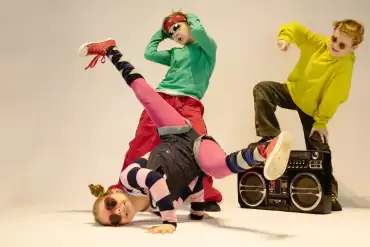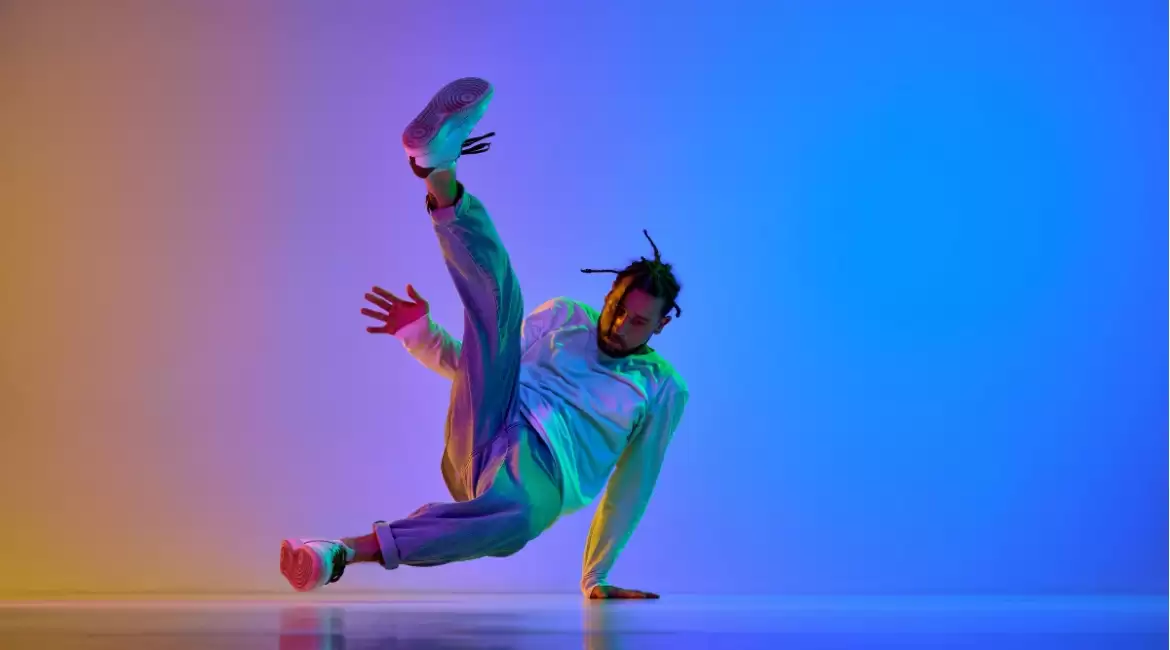In this comprehensive guide, we delve into the diverse facets of hip hop dance, from its historical roots and foundational elements to its evolution into a multifaceted art form embraced by communities around the world. Whether you’re a seasoned enthusiast or a curious newcomer, join us on a journey to uncover all you need to know about hip hop dance – its styles, techniques, influential figures, and enduring impact on contemporary culture. Prepare to be immersed in the pulsating world of hip hop dance, where creativity knows no bounds and self-expression reigns supreme.
What is Hip Hop Dance?
Hip Hop Dance is a kind of dance marked by bouncy steps and sways, danced to Hip Hop tunes. It has strong ties to African American culture, originating in Black neighborhoods of 1970s New York. Although often seen as just one dance style, Hip Hop dance is actually a piece of a larger Hip Hop culture puzzle, which includes DJing, graffiti art, MCing, and breakdancing.

The History of Hip Hop
Hip hop dance emerged from the streets of the Bronx, New York City, in the late 1970s. Unlike the rapid rise of rock music in Canada, hip hop’s influence on music, fashion, and dance took time to develop. It remained largely underground in Canada until the early 2000s, despite a brief surge in popularity between 1989 and 1991.
Its widespread recognition came with the formation of the first professional street dance crews, such as the Rock Steady Crew, The Lockers, New York City Breakers, and The Electric Boogaloos. Many hip hop dance moves originated from funk styles of the 1990s, like the Running Man, the Worm, and the Cabbage Patch. The early 2000s introduced new dances such as the Cha Cha Slide and the Dougie.
While “hip hop” typically refers to a music style, it encompasses various elements that define its culture. Key components include rapping, DJing, breakdancing, and graffiti art. Additionally, it encompasses beatboxing, street entrepreneurship, hip hop slang, fashion, and more. The advent of new media platforms in the 2000s, like MySpace, YouTube, SoundCloud, Worldstarhiphop, and Spotify, facilitated hip hop’s global spread. These platforms amplified the culture’s influence, allowing artists worldwide to experiment with new sounds and styles, further enriching the hip hop landscape.
East Coast Roots
Although hip hop originated in New York City, its roots run much deeper than the digital age. Long before the internet era, artists in the city laid the groundwork for a unique style and vibrant dance culture. Before it gained the name “hip hop,” this art form flourished on the East Coast, thanks in large part to DJ Herc, a Jamaican immigrant who settled in Brooklyn at the age of 12.
As one of the trailblazers of the genre, DJ Herc embarked on an informal career in performance, quickly rising to prominence as one of the most sought-after DJs in NYC. His innovative approach to music production, using two record machines with identical records, paved the way for one of hip hop’s foundational elements. Additionally, he revolutionized song structures by extending the dance sections, recognizing the crucial role dancers played in shaping the essence of hip hop culture.

West Coast Hip Hop
While West Coast hip hop drew inspiration from its Bronx origins, it forged its own distinctive style. Influenced by the music of the Jackson Five from the 1960s and 1970s, dancers on the West Coast incorporated robotic movements into their repertoire, adding a unique flavor to the hip hop scene. These robotic moves, inspired by artificial life, played a pivotal role in shaping the dance culture on the West Coast.
Two key figures emerged as pioneers of West Coast hip hop: Boogaloo Sam, credited with creating “popping,” and Don Campbellock, known for inventing “locking.” These iconic dance moves became synonymous with West Coast hip hop and left an indelible mark on the genre’s landscape. Through their contributions, Boogaloo Sam and Don Campbellock helped define the vibrant and dynamic hip hop scene on the West Coast.
Why Hip Hop Remains the Most Popular Dance Style
Hip hop dance, despite its roots reaching back decades, continues to captivate dancers of all ages and backgrounds. Its enduring popularity can be attributed to its broad appeal. Unlike classical dance forms that often have strict age and body type requirements, hip hop welcomes anyone eager to learn and move. Its versatility allows for performances ranging from grand stage shows to casual club outings with friends.
In today’s cultural landscape, it’s nearly impossible to escape exposure to hip hop dance, whether through live performances or on television screens. Its dynamic fusion of sharp and fluid movements set to music makes it a compelling art form both to witness and participate in. The infectious energy and rhythmic beats of hip hop have a universal appeal, drawing in audiences from all walks of life.
These factors collectively contribute to hip hop’s status as the most prevalent and beloved dance style in contemporary culture. Its accessibility, adaptability, and inherent allure ensure its enduring popularity for generations to come.
The 5 Elements of Hip Hop culture
- Deejaying: Also known as turntabling, deejaying is an artistic expression where music is crafted live using record players and DJ mixers. DJs within the Hip Hop community are tasked with curating and creating the beats that ignite the dance floors at parties and gatherings.
- Emceeing: The MC, short for “Master of Ceremonies,” serves as the energetic catalyst alongside the DJ. They pump up the crowd and often engage in freestyle rap sessions to complement the music.
- Graffiti: Graffiti serves as a canvas for self-expression, using spray paint to depict everyday life on walls and outdoor spaces. It’s a vibrant form of art deeply rooted in the urban landscape.
- Breaking: Breaking, sometimes known as breakdancing, is the original dance style born from the Hip Hop community. It comprises fundamental movements like Top Rocks, Fast Footwork, Back Rocks, Freezes, and Power Moves, showcasing agility, strength, and creativity.
- Knowledge: Knowledge acts as the cohesive force binding the other elements together. “Knowledge of self” refers to a blend of spiritual and political awareness stemming from Afro-diasporic roots. It aims to empower marginalized communities by advocating for social change and uplifting minority voices.
Although some longstanding members of the Hip Hop community may argue for the inclusion of additional elements like Beatboxing, consensus prevails that active participation in the aforementioned five pillars is essential to embody authentic Hip Hop culture.

5 Hip Hop Dance Styles
Hip hop dance is a rich tapestry woven from various influences, resulting in a multitude of distinctive styles:
- Freestyle: Freestyle hip hop dancers thrive on spontaneity, crafting their movements on the spot without predetermined choreography. Drawing from their repertoire of skills and techniques, freestylers effortlessly string together fluid motions, often guided by an innate sense of rhythm and creativity.
- Krumping: Originating from African American communities, krumping is a visceral expression of raw emotion and vigor. Dancers unleash their inner intensity through vigorous movements like chest bumping, conveying profound feelings with a lyrical flair.
- Popping: Characterized by rapid muscle contractions, popping creates a mesmerizing jerking effect across the dancer’s body. Virtually every body part can be popped, resulting in a surreal and robotic aesthetic that captivates audiences.
- Locking: In locking, dancers seamlessly transition between dynamic movements and freeze them in striking poses. Similar to popping, locking involves quick shifts in body positions but emphasizes holding these positions for extended periods, adding an element of precision and control.
- Breakdancing: Often viewed as a distinct subset of hip hop dance, breakdancing embodies athleticism and agility. B-boys and B-girls showcase their prowess through intricate floorwork, executing gravity-defying spins and contortions with finesse and flair.
Each hip hop dance style offers a unique expression of movement, reflecting the diverse cultural influences and individual creativity within the vibrant hip hop community.
What are the main instruments used in hip hop music?
Hip hop music originally relied on basic instruments like turntables and a DJ mixer during its inception in the 1970s. However, as technology advanced, producers began incorporating a wider array of instruments into their compositions. Digital samplers, sequencers, drum machines, and synthesizers became common tools in creating hip hop beats. Additionally, producers occasionally incorporated traditional instruments like electric guitars and bass to add depth and variety to their tracks. Over time, hip hop music has evolved to encompass a diverse range of sounds and instrumentation, reflecting the ever-changing landscape of musical innovation.

Summary
In conclusion, hip hop dance transcends mere movement; it embodies a cultural narrative of resilience, creativity, and self-expression. From its humble beginnings in the Bronx to its global influence today, hip hop dance has evolved into a powerful medium for storytelling, community building, and artistic innovation.
As we continue to celebrate and honor the legacy of hip hop dance, let us remember its roots, embrace its evolution, and champion its ongoing contributions to the rich tapestry of global culture. In the words of hip hop pioneer Afrika Bambaataa, “Hip hop is something you live, it’s something you love, and it’s something you celebrate.” So let’s keep dancing, keep creating, and keep spreading the joy of hip hop dance to all corners of the world.
Author Profile
Latest entries
 Break DanceFebruary 23, 2025Tap Dancing vs. Clogging: How Do They Differ?
Break DanceFebruary 23, 2025Tap Dancing vs. Clogging: How Do They Differ? Break DanceFebruary 23, 2025Best Dance Competitions for Kids
Break DanceFebruary 23, 2025Best Dance Competitions for Kids Break DanceFebruary 23, 2025Master the Straddle Stretch for Splits
Break DanceFebruary 23, 2025Master the Straddle Stretch for Splits Break DanceFebruary 14, 2025The Art of Timing in Dance
Break DanceFebruary 14, 2025The Art of Timing in Dance


Leave a reply